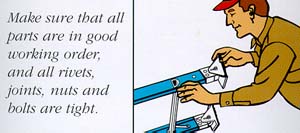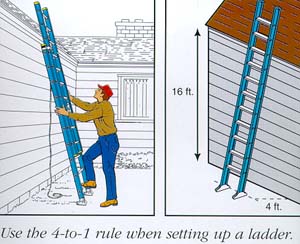Climb it safe
Use ladders safely
Everyone uses ladders to reach out-of-the-way objects on pantry shelves or closets, to wash windows or clean gutters on the roof of a house. Ladders are so useful and commonplace that they are often taken for granted.
That's a mistake, because falling off a ladder also is commonplace. Ladders are useful tools, but if you do not follow the proper safety tips, you could hurt yourself. In fact, according to the U.S. Consumer Product Safety Commission, more than 547,000 people were treated in hospital emergency rooms, doctors' offices, clinics and other medical settings in 2004 because of injuries related to ladder use. Most of the injuries are cuts, bruises and fractured bones.
Orthopaedic surgeons who treat these injuries, and the American Ladder Institute know that many of these injuries and deaths could be avoided by following safety guidelines on the use of ladders.
Use the correct ladder
Use a ladder of proper length to reach the working height you need. Inside a house, that probably means a low stepladder; outside, you may need a taller stepladder, and for some projects, an even taller single or extension ladder. Use a ladder according to use and working load-the combined weight of the climber and the load being carried.
| TYPE |
DUTY RATING |
WORKING LOAD |
|
IA
|
Industrial
|
extra heavy 300 lbs. maximum
|
|
I
|
Industrial
|
heavy 250 lbs. maximum
|
|
II
|
Commercial
|
medium 225 lbs. maximum
|
|
III
|
Household
|
light 200 lbs. maximum
|
Inspect the ladder
Always inspect the ladder before you use it. Never use the ladder if it is damaged, broken or bent.

Don't make a temporary repair of broken or missing parts and then use the ladder. The temporary repair could fail while you're high off the ground. A ladder should be free from grease, oil, mud, snow and other slippery materials before using.
Moving the ladder
You should carry a single or extension ladder parallel to the ground. Hold the side rail in the middle of the ladder so you can balance the load. You should get help moving a very long ladder.
You should always carry a stepladder in the closed position.
Setting up the ladder
Before you use a single, extension or stepladder outside the house, make sure it will not hit electrical wires, tree limbs or any other obstructions when it is extended.
To ensure that the ladder is stable, place the feet of the ladder on firm, even ground.
The bottom of the ladder should be 1 foot away from the wall for every 4 feet that the ladder rises. For example, if the ladder touches the wall 16 feet above the ground, the feet of the ladder should be 4 feet from the wall. If you are going to climb onto a roof, the ladder should extend 3 feet higher than the roof. The upper and lower sections of an extension ladder should overlap to provide stability.

Recommended height of a ladder
| 16 ft. ladder |
13 ft. maximum work height |
| 24 ft. ladder |
21 ft. maximum work height |
| 28 ft. ladder |
24 ft. maximum work height |
| 32 ft. ladder |
29 ft. maximum work height |
| 36 ft. ladder |
32 ft. maximum work height |
Before using a stepladder, make sure it is fully open, and the spreaders or braces between the two sections are fully extended and locked.
Whether inside or outside the house, do not place stepladders or utility ladders on boxes, countertops or unstable surfaces to gain additional height.
The highest standing level on a stepladder should be two steps down from the top.
Using the ladder
Before climbing a ladder, make sure the locks are secured and the bottom and top of the ladder rails are on firm surfaces. The soles of your shoeshould be clean so they don't slip off the ladder rungs. Don't wear leather-soled shoes-they can be slippery. Your shoelaces should be securely tied. Make sure your shoe-laces and pant legs are not so long that they extend under your shoes and cause you to slip.
- Face the ladder while climbing and stay in the center of the rails. Grip both rails securely while climbing. Do not lean over the side of the ladder. Your belt buckle should not be further than the side rail.
- On single or extension ladders, never stand above the third rung from the top and never climb above the point where the ladder touches the wall or vertical support.
- On stepladders, never stand on the paint shelf, spreaders or back section.
- Never stand on the top rung of any ladder.
- Don't overreach; it's safer to move the ladder to a new location when needed. Don't try to "jog" or "walk" the ladder to a new location while standing on it. Climb down and reposition the ladder.
- Don't overload a ladder; it is meant to be used by only one person at a time.
- Never use a ladder in high winds.
- Do not use any ladder if you tire easily, are subject to fainting spells or are using medications or alcohol that make you dizzy or drowsy.
What to do if you fall from a ladder
-
Calmly assess the situation and determine if you are hurt.
-
Get up slowly.
-
If you feel that an injury has occurred which prevents standing or walking, don't panic. Call for assistance. If the injury is serious, call 911.
-
If you are not injured, rest for awhile and regain your composure before climbing again.
Ladders are useful tools, but they must be used properly to avoid turning a household chore into a trip to the emergency room or a physician's office.
Reviewed 2000
All Information Copyright © American Academy of Orthopaedic Surgeons
www.aaos.org